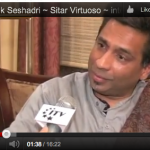Category Archives: Homepage Posts
Kartik and Anindo
NWEAMO
NWEAMO:  Animation Film Festival at the Science Museum IMAX theatre. March 23, 2014: Seshadri improvised to “Vishwaroop” a masterpiece by director Vibeke Sorensen.
Animation Film Festival at the Science Museum IMAX theatre. March 23, 2014: Seshadri improvised to “Vishwaroop” a masterpiece by director Vibeke Sorensen.
University of Oregon Eugene
Varanasi Bhopal Concerts
India Tour December 26 – January 23, 2013
 India Tour December 26 – January 23, 2013 ~ begins in Kolkata with the Indo Occidental Symbiosis Festival of ICM, Ahmedabad’s SAPTAK festival and culminating in the prestigious Dover Lane Music Conference, Kolkata. This entire tour is offered as an homage to Pandit Ravi Shankar. Check Tour Dates for further information.
India Tour December 26 – January 23, 2013 ~ begins in Kolkata with the Indo Occidental Symbiosis Festival of ICM, Ahmedabad’s SAPTAK festival and culminating in the prestigious Dover Lane Music Conference, Kolkata. This entire tour is offered as an homage to Pandit Ravi Shankar. Check Tour Dates for further information.
Homepage Posts 150th Celebration
Homepage Posts Conrad Prebys UCSD Concert
 Full house for sitar maestro Kartik Seshadri at UCSD’s Conrad Prebys Music Center on April 11, 2012, sweeping the audience on a journey through classical Indian ragas that evoked a range of moods, from quiet and thoughtful to bursting with joy. The synergy between Seshadri and tabla virtuoso Arup Chattopadhyay was supernatural, and the performers were honored with an ovation that lasted several minutes. Afterwards, we floated out to our cars and returned to the material world. Dirk Sutro, UCSD Publicity
Full house for sitar maestro Kartik Seshadri at UCSD’s Conrad Prebys Music Center on April 11, 2012, sweeping the audience on a journey through classical Indian ragas that evoked a range of moods, from quiet and thoughtful to bursting with joy. The synergy between Seshadri and tabla virtuoso Arup Chattopadhyay was supernatural, and the performers were honored with an ovation that lasted several minutes. Afterwards, we floated out to our cars and returned to the material world. Dirk Sutro, UCSD Publicity
Headline Posts Songliines Magazine
 Songlines Magazine, U.K. March 2012 acclaim for Seshadri’s album Sublime Raga(s) as “Top of the World”March 2012: again features Seshadri’s latest recording as their Top of the World 10 albums further citing him as “Today’s greatest sitar player . . .” click here to read full review.
Songlines Magazine, U.K. March 2012 acclaim for Seshadri’s album Sublime Raga(s) as “Top of the World”March 2012: again features Seshadri’s latest recording as their Top of the World 10 albums further citing him as “Today’s greatest sitar player . . .” click here to read full review.
Headline Posts Masters of Indian Music series
Masters of Indian Music series
By Mickela Mallozzi
 Posted on February 10, 2012
Posted on February 10, 2012
We entered the main hall of the Upper West Side’s Symphony Space, a one-foot raised platform on the stage covered with a full, Persian rug and with multiple, classical Indian instruments. In the center, a beautifully carved sitar, deep brown wooden body with a silvery-gold neck of strings and tuners, sat proudly to be admired by the audience, waiting to share its voice with the crowd.
[DDET VIEW / HIDE]
The World Music Institute’s Masters of Indian Music series began with an evening of virtuosic music by Kartik Seshadri, accompanied by Arup Chattopadhyay on tabla. Long-time friends, these two performers opened their conversation with each other to the entire audience to listen in. Kartik introduced himself as he sat, cross-legged and twisted, covering his right foot with a brown shawl. He began to tune his instrument, all 22 strings, using the drone of the tambura as his “tuning fork” – intermittently, the tabla was being hammered out, tuning to the same drone of the tambura. After what seemed like an almost comical amount of time to tune an instrument, Kartik began to describe the piece he was about to play. With skill heavily dependent on improvisation, this piece was a specific raga celebrating the coming of spring (this time of year to be celebrated in India); a multi-faceted piece, composed of a slower, rubato section of improvisation and then a faster, more staccato section with audible themes.
This was when you noticed why the instruments were ceremoniously tuned – the microtones and overtones used in this music are so exact that even a slight miscalculation would be as cacophonous as fingernails on a chalkboard. Throughout the first piece, Kartik had been simultaneously and seamlessly tuning his instrument as his fingers quickly plucked the metallic sounds out of the giant gourd instrument. It was like listening to magic, a story that unfolded before your ears with narrative and plot and heroes and heroines: a 30-minute composition that brought you on a journey to a place on the other side of the globe.
Kartik remained calm and almost in a meditative state, keeping his posture the same (cross-legged and twisted, sitar resting on his left bare foot). As I mentioned before, his right foot had been covered by a dark, brown scarf, and as he would ever-so-often keep tempo with that foot, his body shape-shifted into a mystical figure, found maybe in the oceans of Atlantis (a mer-man of sorts). His “tail” keeping odd-metered time with his song added even more to the idea of the demi-god like status to his musicianship.
Known for playing full-length solo recitals on sitar at the age of six, Kartik had truly been touched by the gods. The second piece, initially similar to the first, grew with its story, and Arup’s tabla playing joined in as a second voice. I had never noticed until this performance that true tabla playing is not a percussive accompaniment but a melodic voice adding to the piece. The tabla had hundreds of different sounds, tones, feels, moods, and voices coming from just two, quick hands and two, small drums. It was remarkable, hearing this melody from a drum; the interactions that the two musicians had while composing intricate polymeters and polyrhythms and then joining in unison for exactly three or four beats was synchronicity on a whole other level. At some point during one of Arup’s solos, his hands were moving so quickly, they reminded me of wings of a hummingbird; you know they are there and you can hear them working, but you can’t make out a clear picture of what they are doing.
With the two friends ending their journey together, the audience was reminded of the reality that awaited them outside: a cold and grey metropolis. A beautiful evening of transcendent music, thank you Kartik and Arup for sharing your life’s work – my hands touch both your feet in reverence.
Interview Part One
With Renee Lobo
Interview Part Two
[/DDET]

 icago Cultural Center, September 19, 2015 – World Music Festival ~ Kartik Seshadri perfoming a dawn concert at 6 a.m. ~ greeted by a full house, incredible setting and a beautiful selection of morning Ragas
icago Cultural Center, September 19, 2015 – World Music Festival ~ Kartik Seshadri perfoming a dawn concert at 6 a.m. ~ greeted by a full house, incredible setting and a beautiful selection of morning Ragas

